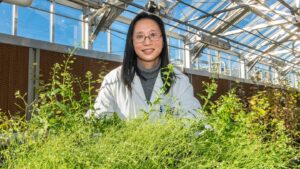
Flying Jets on Feedstock
Last fall, the world’s first flight segment on 100 per cent renewable, drop-in biofuel was conducted by the National Research Council of Canada using its Falcon 20 jet. The drop-in fuel was produced using Agrisoma’s Resonance Energy Feedstock, a dedicated industrial oilseed that was launched at commercial scale in 2012 across a broad region of Western Canada. “This flight represents the culmination of a significant and strategic effort within Canada to demonstrate leadership in green aviation, from the commercialization of a sustainable and scalable feedstock crop to an ‘at altitude’ flight demonstration with real-time emissions monitoring during the flight. Agrisoma is proud to be a part of this landmark work,” says Steven Fabijanski, president and CEO of Agrisoma, who was present on the tarmac. “To date, all powered flight has relied on fossil fuel. This flight changes everything: we have witnessed petroleum-free aviation.” Canterra Seeds was named by Agrisoma Biosciences early in 2013 as the company’s exclusive seed production contracting partner for Resonance.
Find Your Forte and Work It
“As consolidation occurs, bigger companies need to simplify their businesses and standardize their products in order to do it well over a large area, so the bigger they get the more they miss the niche markets or certain customer segments. As a result, that opens up cracks that small and medium companies can dive into and focus on and do well. My point here is that the biggest opportunities I see for differentiating yourself against some of the larger national brands is to find a certain customer segment you can serve better than they can, or a way of doing business that you can do better than they can. Can you offer better customer service? The bigger they get the more standardized they have to become, and that opens up more opportunities for smaller companies to be flexible, to focus on and love the customer, and at the end of the day if they can be more flexible they’ll continue to have that customer base.”
—Rob Hannam, founder and president, Synthesis Agri-Food Network
Vegetable Oil Industry Fires Back at Misleading Claims
A story during CBC’s The National in early February, which suggested that nutritional recommendations calling for a replacement of saturated fatty acids with polyunsaturated fatty acids should be reconsidered, was misleading, says the Vegetable Oil Industry of Canada. In a press release, VOIC said the story was based on a recently published paper in the British Medical Journal by Ramsden et al. raising concerns about the impact of Omega-6 (a polyunsaturated fat) as substitutes for saturated fatty acids. “This paper contains a new analysis of old data recovered from the Sydney Diet Heart Study conducted in 1969–73. That study’s participants, men with a history of cardiovascular disease, were tested with very high doses of Omega-6 at 15 per cent of daily energy, which is more than three times the intake level of Canadians,” said the press release. “CBC’s viewers would have been better served had the story focused on the substantial body of evidence supporting a recently approved health claim in Canada advising consumers to replace dietary sources of saturated fat with polyunsaturated and monounsaturated fats from vegetable oil to lower cholesterol … The evidence submitted to Health Canada in support of the claim by the Vegetable Oil Industry of Canada concurs with the Institute of Medicine’s Dietary Reference Intakes for Energy, Carbohydrate, Fiber, Fat, Fatty Acids, Cholesterol, Protein and Amino Acids’ which included evidence from both observational and clinical studies. This authoritative report concludes that ‘monounsaturated and polyunsaturated fatty acids reduce blood cholesterol concentration and help lower the risk of heart disease when they replace saturated fatty acids in the diet.’”
Future of Indian Seed Industry
“Limited availability of agricultural land, diverse use of agricultural crops leading to rising food crop prices, subsidies by the government to use high-yielding varieties to increase productivity and other multiple factors are driving the growth of the Indian seed industry as robust seeds with vitality to increase the yield from the limited area under acreage coupled with effective crop management is need of the hour to ensure food security in India,” said D.S. Rawat, secretary general of the Associated Chambers of Commerce and Industry of India while releasing the chamber’s recent analysis on the “Future of the Indian Seed Industry.” Growing at a compounded annual rate of about 15 per cent, the seed industry in India is likely to reach the Rs 10,700 crore mark (107 billion) by 2015 from the current level of about Rs 7,000 crore (70 billion), according to ASSOCHAM. The production level of seed in India is also likely to grow from the current level of about 40 million quintals (4 billion kilograms) to about 63 million quintals (6.3 billion kilograms) by 2015. “The seed companies are required to convince farmers to abandon conventional seeds in favour of high-yielding hybrid seeds as the switch can help the farmers get high yields, fetch better prices for their produce and almost triple their income,” said Rawat. “Besides, public-private partnership, together with a strong regulatory framework and collaborative research are other key measures to ensure smooth growth of the seed industry.”
Seed Quality in 2013
In its winter newsletter, BioVision released seed quality statistics on germination and diseases. Business development manager, Holly Gelech, says “the data represents a very large samples set—except those with an asterisk—so it is representative of our analysis for the 2012 crop.”
Germination
The germination results have been solid to date due to limited frost damage and dry weather during the harvest months. Soybeans are the one crop in which germination is below expectations and, in some cases, below the Grade Table standards. The extreme dry weather conditions during soybean seed maturation and harvest is thought to have contributed to abnormal seedlings in the germination test.
| Germination Range | Average (’12) | Average (’11) | ||
| Wheat | Alberta | 59-100% | 96% | 95% |
| Saskatchewan | 43-99% | 92% | 93% | |
| Manitoba | 78-99% | 93% | 95% | |
| Barley | Alberta | 24-100% | 95% | 92% |
| Saskatchewan | 60-99% | 92% | 90% | |
| Manitoba | 90-99% | 96% | 92% | |
| Oat | Alberta | 1-100% | 90% | 91% |
| Saskatchewan | 58-99% | 94% | 95% | |
| Manitoba | 95-98%* | 97% | 92% | |
| Pea | Alberta | 8-99% | 89% | 90% |
| Saskatchewan | 50-100% | 91% | 91% | |
| Lentil | Alberta | 33-96%* | 97% | 95% |
| Saskatchewan | 73-99% | 95% | 95% | |
| Soybean | Manitoba | 55-95% | 83% | 94% |
| *Limited Data Set |
Seed-Borne Diseases
Seed-borne pathogens are higher this season, which is not a surprise considering the wet weather conditions and heavy canopy cover during the key infection periods. Seed treatment will be a very important tool to manage disease in 2013, as well as best management practices such as crop rotation. The one positive story from the disease lab is that ergot in wheat is less of a concern this season.
| Infection Range | Average (’12) | Average (’11) | ||
| Ascochyta spp. (peas) | Alberta | Not Detected – 23% | 7.1% | 3.0% |
| Saskatchewan | Not Detected – 30.5% | 7.9% | 5.0% | |
| True Loose Smut (barley) | Alberta | Not Detected – 4% | 1.68% | 1.1% |
| Saskatchewan | Not Detected – 3%* | |||
| Fusarium graminearum (wheat) | Alberta | Not Detected – 14% | ||
| Saskatchewan | Not Detected – 46% | |||
| Manitoba | Not Detected – 20.5% | |||
| Fusarium graminearum (barley) | Alberta | Not Detected – 22.5% | ||
| Saskatchewan | Not Detected – 9.5% | |||
| *Limited Data Set |














